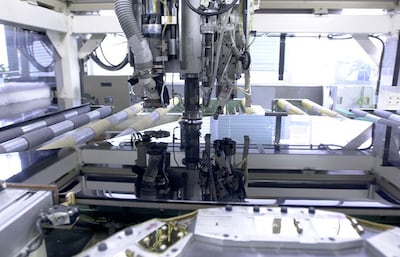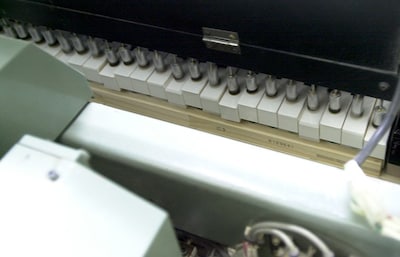Mounting the Dampers, Installing the Lid, and Resting
These Assembly Operations Mark the End of the First Stage
Mounting the dampers, which play a role in stopping the sound, and installing the lid mark the completion of the assembly process. After this, the focus will be on perfecting the quality and integrity of the instrument.
A mirror is used to check the position of the damper head
The gold-colored hinge is mounted on the lid in a fully automatic process
Seasoned for 7 to 10 Days
After the lid is installed, the automatic key pressing machine is used once again to give the keyboard and action a thorough run-in, and to ensure that the hammers are adjusted to strike the strings cleanly and evenly. The machine actually plays each key 300 times.
After being played by the automatic key pressing machine, the instrument is seasoned for 7 to 10 days. Before final adjustments are made, the piano is placed in a flow rack system and allowed to sit undisturbed in an environment where the temperature and humidity level are set based on the climate of the customer's location.
Musical Instrument Guide : Piano Contents
Origins
Structure
How to Play
How the Instrument is Made
Choosing an Instrument
Care and Maintenance
Trivia
- The White Keys and Black Keys Were Reversed on Pianos in Mozart's Day
- Did Mozart's Piano Have a Pedal-Board?
- Piano with Automatic Accompaniment System in Beethoven's Day
- The Pianos Beloved by the Great Master, Sviatoslav Richter
- The Optimal Material for Piano Frames Is Also Ideal for Motorcycle Engines
- The Piano Soundboard Is a Board that Also Stops Vibrations
- Why Can't There Be More Than 88 Keys on a Piano?
- Why a Grand Piano Keyboard Feels Heavier Than an Upright Keyboard?



